The Real Wirth (Werth?) of a Bruce Robinson Rookie Card
OR -- I'll give you a Lollar for that Murphy
Note: When you click on links to various merchants in this newsletter and make a purchase, this can result in this newsletter earning a commission. Affiliate programs and affiliations include, but are not limited to, the eBay Partner Network and Amazon Associates.
1981 Topps Bruce Robinson (#424) - Card of the day
(affiliate link)
Some things in life are just about finished when it seems like they’re just getting started. And sometimes, they’re completely finished when it seems like they’re just getting started.
Take Bruce Robinson’s big league baseball career, for example.
Originally drafted by the White Sox in the fourth round out of La Jolla High School in 1972, Robinson instead took his catching talents to Stanford. There, he set the school record for home runs in a season and still holds the mark for wooden-bat homers.
The extra seasoning paid off for Robinson at draft time, too, when the A’s made him their first-round pick in June 1975. Three years later, he was in his second stint at Triple-A when Oakland called him up in August. He made it into 28 games down the stretch in 1978, batting .250 with almost no power (and no homers), but mostly handling himself fine in 199 innings behind the plate.
Topps took a sip of that cup of coffee and liked what they tasted enough to include Robinson in the marquee slot on the 1979 A’s Prospects card (#711):
(affiliate link)
This pasteboard would turn into a minor sensation a few years later as the rookie card of Dwayne Murphy, who also ended up being a minor (though underrated) sensation. As things worked out, Alan Wirth peaked as a rookie in 1978, going 5-6 with a 3.43 ERA for the A’s. He managed just 14 more innings over seven appearances in 1979 and 1980 before wrapping his career at 6-6 with a 3.78 ERA.
And, as things also worked out, maybe there wasn’t enough room for three men — or even two — on Murphy’s RC. Because, by the time the first collectors pulled this card from wax packs in 1979, Robinson was gone, sold to the Yankees for a reported $400,000.
After a summer at Triple-A Columbus, Robinson found himself in the catching mix in the Bronx in September 1979 following Thurman Munson’s death.
A .167 batting average in 13 plate appearances wasn’t enough to earn Robinson a spot on the Yanks’ — or Topps’ — 1980 roster.
It was more of the same for Robinson in 1980, though he did crack a career-high 12 dingers for Columbus before another call-up to New York. In four big league games that September, he went hitless in five at-bats…and struck out four times.
Topps was duly impressed with that age-26 season and brought Robinson back in 1981, front and center, in the Yankees Future Stars card you see at the head of this post. As for his card mates, Tim Lollar turned in a star-level season for the Padres in 1982 and pitched parts of seven seasons in the bigs, while Dennis Werth spent time in the majors in both 1981 (Yankees) and 1982 (Royals).
Robinson, not so much. He never did make it back to the big leagues, though he did bounce around the minors until 1984. That makes his 1981 Topps second-chance rookie card a sort of backhanded career-capper, too, though one without any playing stats on the back.
No word on whether Robinson considered a comeback in 2002 or 2010 to try to land on a rookie card with either Jayson Werth or Danny Worth.
We do know, though, that Bruce Philip Robinson was born on April 16, 1954.
1990 Fleer Was Good for Something, After All
For my money, 1990 Fleer was about the Junk Waxiest of all Junk Wax issues, though it certainly had some other “fine” competitors. But that doesn’t mean the baseball card equivalent of cockroaches (it’s everywhere, and you can’t kill it) was/is completely without its charms.
Did you know, for example, that the 1990 Fleer Dwayne Murphy card tells about as a complete baseball story a swath of white cardboard-like substance can? Read all about it right here.
Official 1978 Baseball Guide
As Bruce Robinson was gearing up for the season that would first deliver him to the big leagues, baseball fans were busy snatching up all the information they could about the upcoming campaign. That usually meant hitting the newstands, and one yearly source of hardball reads was The Sporting News Official Baseball Guide. As it turns out, you can still find many of these for sale online today for fairly cheap — here are the related Amazon listings for the 1978 version, for example.
(affiliate link)







